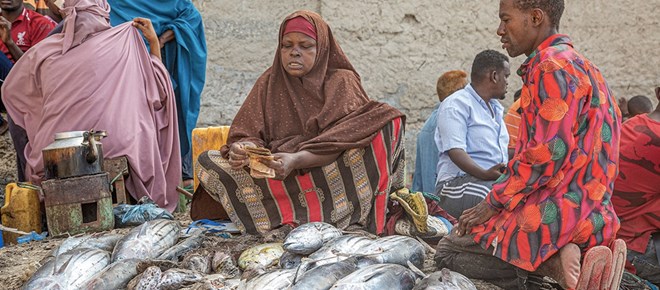
Wednesday March 23, 2022

In Somalia, entrepreneurship is a driving force of the economy. An estimated 76%of all jobs come from entrepreneurial activities - and except for large businesses, women play a leading role in this area.
In Somaliland, women own more than half of all household enterprises. In Mogadishu and Bossaso, they own approximately 45% of established formal businesses.
Many Somali women say they prefer self-employment citing flexibility, freedom, and independence. However, critical gender gaps in entrepreneurship remain; women have lower revenues compared to their male counterparts and are largely excluded from higher-earning segments of value chains. So, what is holding back women entrepreneurs? To try to answer this question, we collected stories from entrepreneurs working in the livestock, dairy, fisheries, retail, and trade sectors in Hobyo, Bossaso, Burao, Hargeisa, and Mogadishu about the challenges women entrepreneurs face. This research is part of the recently concluded Somalia Country Economic Memorandum (CEM), which examined what constraints needed to be overcome to create more and better jobs for Somali men and women.
Across sectors, three issues, stood out:
Women lack access to capital
“Financial institutions have made borrowing so restrictive that it’s almost impossible for women to borrow. This is because, [banks] ask for either a guarantor or security in the form of an asset. Both are not within the reach of women.” – Woman working in the fisheries sector, Hobyo
Many women pointed out that land ownership and inheritance laws favor men, making it very hard for women to meet the requirements necessary to secure bank loans. Some people explained that men do not like to be guarantors for women because they are worried women, who tend to be engaged in small-scale and low-earning businesses, will default on their loans. Other women said they did not consider bank loans because of the cost and the short repayment periods. As a result, most women rely on savings groups or loans from family and friends when they need money. However, the amounts they save and borrow are generally small, making it hard to make large investments in their businesses.
Women’s businesses are concentrated in local daily markets
“Our market is very small and the number of women selling fish are many. Therefore, our big challenge is on market, and the fact that we have no capacity to reach neighboring markets where fish is in high demand.” – Woman working in fisheries sector, Hobyo
Across sectors, women talked about the challenges of operating in constrained local markets. In the dairy and fisheries sectors, for example, women generally cannot afford refrigerators or refrigerated trucks. This means they cannot store or transport their products to nearby towns where they can get better prices and they are therefore stuck selling their products in the daily local market where there can be problems of over-supply. Recent research from Ghana finds that this kind of ‘over-crowding’ leads to lower demand for female-owned firms and lower profits for women. In the livestock sector, women entrepreneurs described seasonal challenges. For example, during the Haj season, when the demand for animals is higher, men with larger operations tend to sell to traders who export to places like Saudi Arabia. This drives the price of livestock up, negatively affecting women who operate smaller businesses, trying to buy livestock for resale in local markets. It was clear that women who operate in more limited markets are at a disadvantage in finding buyers and sellers.
Women’s businesses are often in suboptimal locations
“Most women-run businesses are small, and most of them are based in the neighborhoods rather than the main city center. They therefore have less interaction with suppliers and are often stuck with one supplier.” – Woman business owner, Hargeisa
Across sectors, women described constraints to business location. A combination of household and childcare responsibilities often required women to work close to home. In other instances, prohibitive requirements to pay one or more years rent in advance, and challenges securing a guarantor made it more difficult for women to rent desirable shop space. As a result, it was not uncommon for women’s businesses to concentrate on the outskirts away from city centers or near their homes, impacting their ability to attract and reach clients.
What next?
Under the best of circumstances—much less in times of crisis such as drought, pandemic, or instability—women entrepreneurs often need to be creative and innovative just to keep their businesses going. While more research is needed to figure out how to best support women entrepreneurs in Somalia, innovations in other countries provide clues to the types of interventions that might help.
In Nigeria, for example, the Women Entrepreneurship Finance Initiative is piloting a digital cash flow loan to help women entrepreneurs overcome collateral constraints. In Ethiopia, micro finance institutions, as part of the Women Entrepreneurship Development Project, have used cash-flow lending techniques to reduce collateral requirements for women seeking loans.
In terms of business location, if the obstacle is cost, offering subsidies or help with guarantees could help women secure more optimal business locations. When cost is not the primary obstacle, but rather household and childcare responsibilities, then childcare interventions might be more relevant. In Uganda, for example, a study found that bringing a child to work is associated with a “baby profit gap”— 45% lower profits for women.
As we look for solutions tailored to Somalia, the Africa Gender Innovation Lab is a great place to find other evidence from across the region on how to close the gender gap in earnings, productivity, assets, and agency. If projects are going to better support women, they will need to think about innovative ways of addressing their most pressing challenges. As one male entrepreneur in Hobyo said, “They [women] can do well, if given a chance.”
This blog is part of a blog series curated by the World Bank’s Somalia Women’s Empowerment Platform to highlight evidence and solutions on women’s and girls’ empowerment in Somalia. Read more blogs in the series: